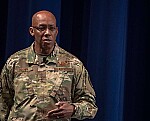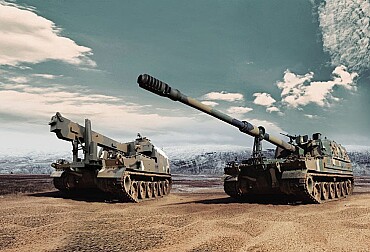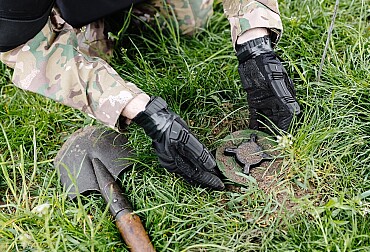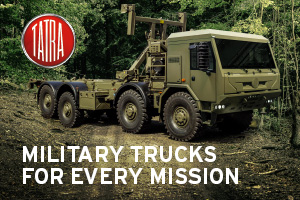Harnessing Emerging and Disruptive Technologies: NATO’s Strategic Edge on the Modern Battlefield
Technological advancement is changing all facets of human life, and the battlefield is no different. Artificial intelligence, autonomous machines, quantum systems, and biotechnology are among the emerging and disruptive technologies (EDTs) that have changed warfare and continue to compel NATO to review its strategies, doctrines, and operational capabilities. With Russia and China actively pursuing these emerging technologies, it is essential for NATO to keep updating itself to maintain its defence and deterrence capabilities. This article analyses the EDTs, their strategic value to NATO, and the Allied States’ constant attempts to re-order their defence systems incorporating such technology.
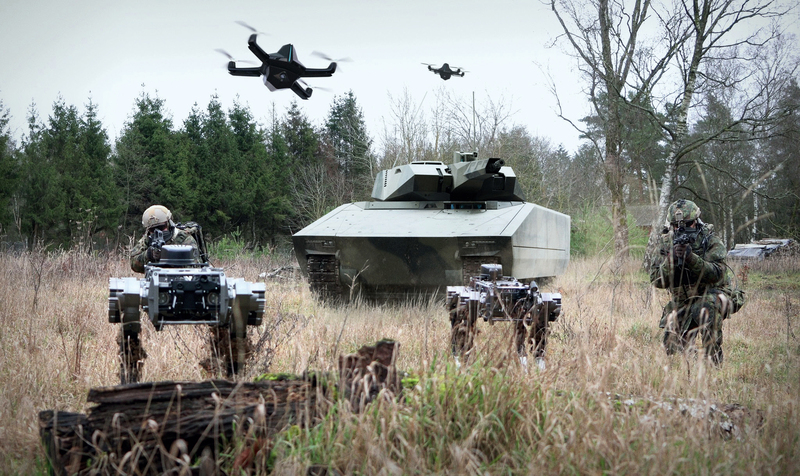
Emerging Disruptive Technologies (EDTs): The Building Blocks of Future Warfare
Throughout history, significant technological advancements have transformed the methods of warfare. From the development of the longbow during the Hundred Years War to the implementation of radar in World War II, each innovation has provided a crucial edge to those who were the first to master it. Today, a new era of technology holds the promise of once again disrupting the battlefield.
The NATO Science and Technology Organisation (STO) defines EDTs as scientific breakthroughs with the potential to revolutionise military operations. These technologies are not just tools for modern warfare; they serve as catalysts for reshaping defense doctrines, operational tactics, and even strategic decision-making.
Artificial Intelligence (AI):
AI is transforming military operations by delivering unparalleled speed and precision in decision-making. NATO has commenced the integration of AI into various aspects of defence, ranging from the analysis of intelligence data to the automation of complex systems. AI's capacity to process enormous volumes of information and identify patterns in real time enables quicker and more informed decision-making. For example, in Ukraine, AI-driven systems analyse satellite and UAV imagery to monitor troop movements and identify potential targets or to identify adversary infiltrators.
Autonomous vehicles and drones are also making use of AI for their navigation, threat detection, and targeting functions. Al-assisted weapons can do high-risk tasks such as striking major targets in the heart of an enemy's land, tasks which otherwise would be executed by humans. However, NATO has expressly stated the necessity of human control so that the Al comply with the appropriate humanitarian and legal norms.
Autonomous Systems:
Unmanned systems, including land based robots, autonomous submarines, and drones are quickly changing the way military operations are carried out. These systems have the capability to operate in hazardous environment and demote the need of human soldiers in dangerous situations. In Ukraine, both Russia and Ukraine have been profligate in their use of drones for reconnaissance, artillery targeting, and offensive actions. Also, progress is happening as we speak, on the development of autonomous ground and maritime vehicles performing reconnaissance, transport, and combat missions. Designed to partner with NATO forces to scout enemy positions and traverse 'hard' terrain while providing Fire Suppression Support and protecting key infrastructure with minimum human supervision, these vehicles are smaller and spartan.
Quantum Technologies:
Although only in its earliest stages of development, the potential of quantum computing and its associated technologies to transform encryption, communication and navigation systems is enormous. Quantum encryption would make NATO communications very secure while the use of quantum sensors would greatly improve surveillance and detection systems above current capabilities. Quantum technologies are expected to extend the capacity to tackle and process big data, supporting areas such as logistics planning and real time decision making in highly complex, multi domain operations.
Biotechnology and Human Enhancements:
As military missions grow more complex, increasingly the need is to improve soldier performance. Human Enhancement Technologies (HET) can be used to augment soldiers physical abilities. Soldiers may have access to smart exoskeletons able to better augment their strength and endurance, or more importantly cognitive enhancements to support better decision making in stressful situations. Work has already started on the possible biotechnological revolution of military training and operations.
Hypersonic Systems:
A new type of danger on the battlefield is emerging, hypersonic missiles capable of speeds higher than Mach 5. Russia's Kinzhal missile has been deployed in the conflict in Ukraine. The challenge is that intercepting hypersonic weapons is extraordinarily difficult as compared to conventional missile defence systems and new, more capable systems need to be developed.
Space Technologies:
The last frontier of military supremacy, space, is engaged in more frequent disputes. Space operations have become an integral part of contemporary defence tactics because NATO relies on space-based resources for surveillance, communication, and navigation. Satellites provide real time ISR (Intelligence, Surveillance and Reconnaissance) with which NATO forces can monitor the activities of the enemy and conduct precise strikes.
Novel Materials and Advanced Manufacturing:
With the rise of advanced manufacturing methods, including 3D printing, NATO starts rethinking the configuration of its logistics and supply chains. By providing speedy production of specialised parts and repair of damaged equipment on site, these advancements bring about tremendous decrease in both time and cost expenditure incurred in logistical operations.
Energy and Propulsion:
Greater energy demands are placed on the more complex, more extended military operations. Battery technology, energy storage and alternative propulsion systems, offer a path to increased operational endurance of NATO forces that would decrease their reliance on exposed fuel convoys and supply routes.
Next-Generation Communications Networks:
Communications in modern military operations need to be completed at high speeds and in secure ways. 5G and next generation Command and Control network could enable speed and dependability opportunities to partners across domains by speeding up and streamlining commands, coordination, and dispositions.
NATO’s Strategic Response: Building the Technological Backbone
NATO has a multi-faceted strategic approach for integrating EDTs. It acknowledges that maintaining its deterrence posture will require technological dominance and thus the Alliance invests a lot in cutting-edge technology research, development, and procurement. NATO has several initiatives that showcase its commitment to staying ahead of its adversaries.
Defense Innovation Accelerator for the North Atlantic (DIANA)
DIANA is one of the initiatives established to try and cope with the rapid pace of technological developments. DIANA enables NATO to collaborate with the private sector in serving as an intermediary between the Alliance and promising civilian technologies able to be made available for military use as soon as possible. The NATO Innovation Fund also provides venture capital to early-stage tech companies to fill in the gap between civilian innovation and its military application.
Responsible AI and Ethical Autonomy
In the world of military operations, the marriage of its AI and autonomous systems has resulted in NATO accentuating the role of ethical factors. In 2021, NATO released its Principles of Responsible AI defining how transparent, accountable, and unbiased AI driven military systems could be.
AI will improve the operational effectiveness of NATO’s forces, but we must ensure there is a need for human supervision in order to prevent unanticipated results on the battlefield.
Interoperability and Multi-Domain Operations (MDO)
That aspect is embraced by NATO to take account of emerging technologies within the land, sea, air, cyber and space domains. This transition enables NATO forces to work together effectively, regardless of whether it is in a difficult, competitive environment, and uses physical and non-physical impacts.
Imagine a NATO operation consisting of the combined use of AI controlled drones, quantum secured communications and self-operated vehicles across all domains, with a result of a combined well unified effect against the adversary they struggle to combat.
Lessons from the Battlefield in Ukraine
The conflict in Ukraine has provided useful experience with the use of EDTs in modern warfare. Ukraine and Russia have mapped out such all-terrain tactics and Ukraine is in fact a proving ground where both have tested and progressed the drone technologies.
Drones as a Modern Artillery
Drones have been used everywhere in Ukraine, from reconnaissance and targeting enemy artillery to direct attacks against enemy positions and systems. It highlights that air superiority is more than just controlling the skies with fighter jets, it requires also the ability to dominate it with drones.
Intelligence Enhanced by AI
Ukraine has turned to AI for battlefield visual analysis, predicting the enemy’s movement; and also, for detecting infiltrators. One of the most current examples of the power of AI in warfare is the use of AI tools such as the Palantir that have given commanders more information to make better informed, faster decisions.
The Importance of Mass
The sheer mass of autonomous systems proved Ukraine’s ability to field thousands at a time, and even overwhelm the most sophisticated defence systems. This experience is now teaching NATO to ramp up its own drone and autonomous platform deployments.
Recommendations for NATO’s Future Strategy
In order to fully maximise the potential of EDTs, it is imperative for NATO to give priority, but not only, to the following:
Enhance Training and Education
NATO should spend some resources to train its personnel on dealing with AI, autonomous systems and other EDTs. By expanding the range of courses offered at the NATO School Oberammergau and NCIA Academy, NATO forces will have the required skills to conduct effective use of these new technologies.
Strengthen Collaboration with Allies and Industry
To maintain a leading position in technology, close cooperation between NATO, its member states, and the private sectors is needed. DIANA together with the NATO Innovation Funds is currently trying to close this gap but more work is needed to see continuous technological advancement.
Establish Resilient Supply Chains
NATO needs to decrease its dependency on foreign suppliers for important components such as semiconductors and rare earth elements. NATO can maintain operational capability during periods of global trade disruption by strong, diverse supply chains.
Navigating the Future of Warfare
Warfare changes and NATO must evolve. Emerging and Disruptive Technologies are the Alliance's future success as the technologies necessary to deter adversaries and protect their members will make them a technological force to be reckoned with.
Through strategic investments, training and doctrine development, not only is NATO building the capacity to withstand, but to thrive in the technologically driven battlespace of tomorrow.





